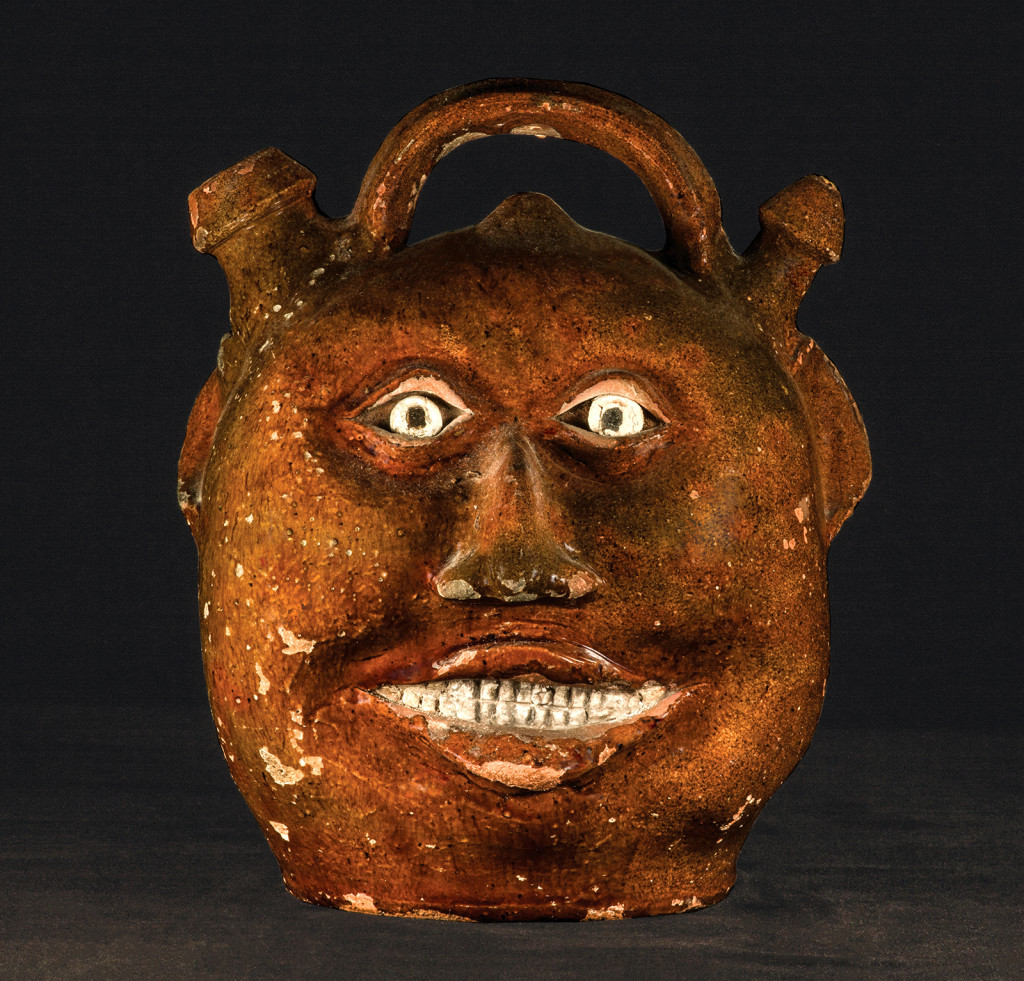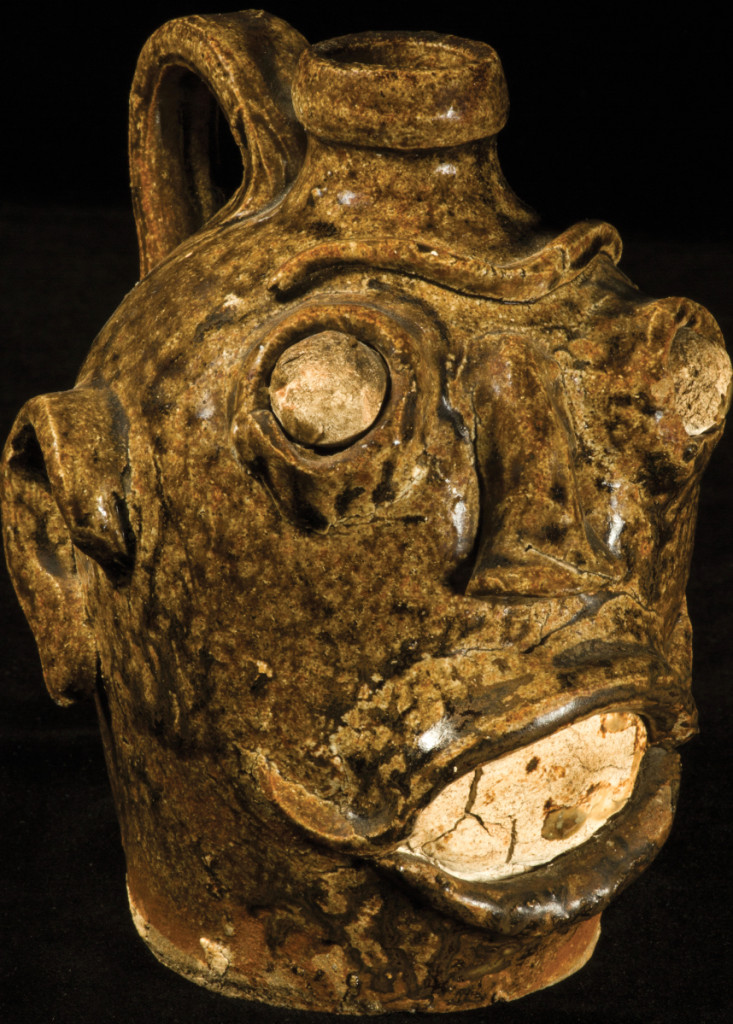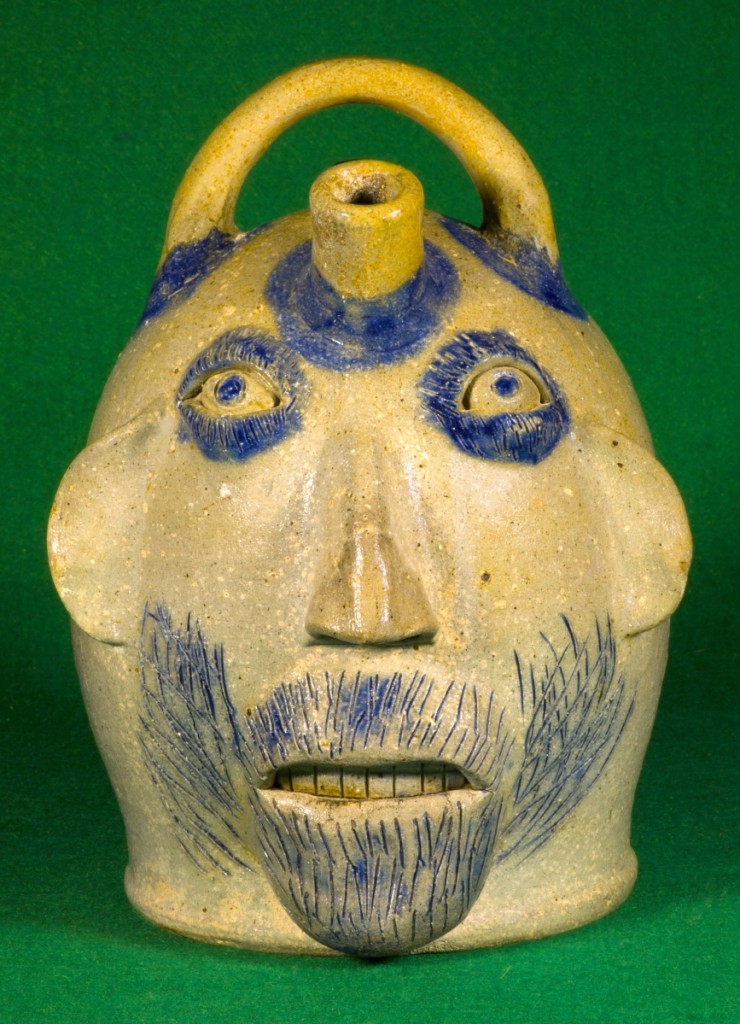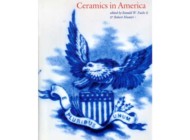
Harvest face jug attributed to Thomas Chandler (1810?–1854), Baltimore, Md., 1825–29. Earthenware with clear lead glaze and white painted details; height 10 inches.
By Laura Beach
COOPERSTOWN, N.Y. – With their exaggerated features and angular contours, stoneware face jugs rival Picasso portraits in their expressive force. But unlike the well-documented paintings of the French master, these humble American vessels often lack known provenance and pedigree, a deficiency addressed by “Early American Face Jugs.” The exhibition, on view at Fenimore Art Museum from June 28 through December 31, and its companion catalog build on regional studies to create the most comprehensive account to date of a distinctive American tradition that spread south and west from the Mid-Atlantic states in the mid-Nineteenth Century.
The show is drawn exclusively from the collection of George H. Meyer, a longtime collector of American folk sculpture who, with his wife, Kay White Meyer, produced the Folk Artists Biographical Index (1987) and American Folk Art Canes: Personal Sculpture (1992). Early American Face Jugs is the latest project for the recently retired attorney and his wife, Michigan residents who have long been active in the American Folk Art Museum and the American Folk Art Society.
Husband and wife fell in love with face jugs, he instantly, she over time. “On first glance, they were ugly,” confesses Kay, who became intrigued with the humanity and individualism of the figures with whom she shared her home. George needed little persuading. “A pretty good face jug turned up years ago at Margaret Brusher’s Ann Arbor Antiques Market and I bought it. That was the start. We were working on canes at the time, but in the past 15 years face jugs have dominated our collecting.”
The Meyers cite the ongoing contributions of David Good, an Ohio dealer known for his expertise in American folk pottery. It was the night before Christmas in 1986 when Good appeared at the Meyers’ door offering what George describes as “a small, important group of face jugs from a collector who was looking to sell all of them as quickly as possible.” George, who focuses on jugs made prior to 1950, bought and culled the group, which included several prized Edgefield examples. The Meyers, who tend to buy privately, have also worked with Philip Wingard, a scholar, collector and antiques broker whose research underpins the project.
The Meyer collection now numbers 114 face jugs and related pieces of pottery, 62 of which are on view in the West Gallery at Fenimore Art Museum, where they are arranged according to geographic origin. The presentation follows a narrative intended to convey the movement of the tradition from region to region and from potter to potter.
“We like the idea of showcasing folk-art expression in clay. While we do have stoneware, this is true folk sculpture of a different medium, function and cultural meaning,” says Paul D’Ambrosio, president and chief executive officer of Fenimore Art Museum and The Farmers’ Museum. Of his first visit to the Meyers’ home, he recalls, “I was astounded by what I saw. There was the quality of the work, which is so expressive and in some cases very raw in its expressiveness. Grouped together, the work is visually stunning and incredibly engrossing. You really see at a glance the breadth of the artistic expression represented.”
As research got underway, Good spent several days examining the jugs with the goal of attributing works to specific potteries and makers. Kay, who delved into the documentation, sought connections among people, places and pots. She writes, “Realizing each community had needed its potters helped me understand something of their craft. The family trees and peregrinations of the potters were amazing. And to understand the importance of geography, and of rivers with their clay deposits, why potters were moving to these locations, and how they inspired one another, was fascinating.”
What emerges is a detailed picture of a craft tradition whose migration echoes the great Westward Expansion of the middle decades of the Nineteenth Century. Makers were of both European and African descent. As Robert Hunter explains, “no other category of American ceramics blurs the social and cultural boundaries between white and black like the face jug – but they likely used them in different ways and for different purposes.”
English Toby jugs and German Bellarmine jugs inspired American face vessels in the European tradition from about the 1820s. A second, more robust tradition began around the same time in Baltimore before moving to the Edgefield District of South Carolina, where it flourished between 1840 and 1865. From there the tradition spread across the South and into the Ohio River valley, kept alive by families of potters who intermarried or simply shared ideas and techniques. Northern stoneware was salt glazed. In the South, the use of wood ash contributed to alkaline glazes in subtly variegated shades of olive green. In most instances, face vessels were made for local or regional customers in established potteries alongside more utilitarian wares.
Standing almost 25 inches tall, a redware cooler glazed with manganese and lead is one of George’s favorite pieces. The head of a jug-eared military man sits atop a conventionally ovoid vessel in this eastern Pennsylvania piece probably dating to the first half of the Nineteenth Century.

Face jug attributed to Dave (1800–circa 1870), Stoney Bluff, S.C., circa 1848–67. Dark ash glazed stoneware, kaolin eyes and teeth, height 6½ inches.
Another key piece from the Mid-Atlantic region is a double-face harvest jug made by either Henry Remmey of Baltimore or his son Richard C. Remmey of Philadelphia around 1850. It is rendered in salt-glazed stoneware, with cobalt accents adding drama to its deeply incised and applied features.
A circa 1825-29 harvest face jug with a round face and a full set of gleaming white teeth may be by Thomas Chandler, Jr. (1810?-1854), a white potter from Baltimore who Wingard credits with transmitting the face-jug form to Edgefield, S.C., where Chandler moved around 1836. The potter made his first Southern face vessels around 1838 at the Shaw’s Creek pottery. He likely inspired other potters, including enslaved Africans, to make the entertaining novelties, which became associated with the Edgefield District soon after Chandler’s arrival there.
Among today’s connoisseurs, Edgefield face jugs command a premium. Crocker Farm recorded a record at auction for an American face jug in July 2017, when it hammered down a circa 1845-55 Edgefield example for $103,300, including premium. Dr John E. Hoar writes about 22 Edgefield objects in the Meyer collection, remarkable, he says, for its size, scope, variety, quality, condition and range. Hoar claims knowledge of 167 Edgefield-related vessels, around 65 percent of which are held privately. The largest known group belongs to Meyer.
A face jug with a turned-up lip and large kaolin eyes and teeth is attributed to Dave (1800-circa 1870), an enslaved African ceramist who worked in Stoney Bluff, S.C., between roughly 1848 and 1867. “Later pots, which he made as a free man, tend not to be face jugs but very large, which takes a lot of skill,” George says.
“Edgefield was an epicenter. Almost all the large potting families in the South started there before fanning out. The relationships were strong and potters continued making a living, though face jugs changed in complexity over the years. The original face jugs were probably not for sale and were highly personal,” Kay writes, describing the migration of talent after the Civil War to Georgia, Alabama, Mississippi and Texas and Midwest to Indiana, Kentucky and Ohio. Production sprang up along the Ohio River valley in the 1870s and 1880s. A cluster of potteries operated in Muskingum County, Ohio alone.

Face jug by Charles F. Decker (1832–1914), Keystone Pottery, Washington County, Tenn. Salt-glazed stoneware with cobalt details, height 9¾ inches.
The Meyers treasure a comical salt-glazed face jug by the German-born, Philadelphia-trained artisan Charles F. Decker (1832-1914), who worked at Keystone Pottery in Washington County, Tenn. The witty ceramic depicts a whiskered gentleman whose upward gaze registers surprise at the spout emerging from his forehead. Securing the pot was an adventure in itself, with half a dozen individuals engaged in the search on the Meyers’ behalf.
Founded in Arden, N.C., in 1925, Brown Brothers Pottery made stoneware face vessels, including large devil jugs used as advertising pieces, in assembly-line fashion, with men turning the pots and women applying the faces. To learn more about potting families, Kay contacted 66-year-old Charlie Brown, grandson of one of the pottery’s founders. “Several late night calls to him were most helpful and gave me insight into the fact that making a living from face jugs is not always easy,” she writes.
Edwin Atlee Barber discussed face jugs in the third edition of his classic guide Pottery and Porcelain of the United States, published in 1909. (As a footnote, Freeman’s auctioned a face jug from Barber’s collection in 1917, a year after the collector’s death. Attributed to enslaved craftsmen working at a small pottery in Bath, S.C., operated by Col. Thomas J. Davies, it achieved a not inconsiderable $27.50.) Roughly coinciding with Barber’s interest, Yankee snowbirds visiting the South Carolina town of Aiken began bringing Edgefield face vessels home with them.
Thanks to George and Kay Meyer and their research partners, contemporary collectors now have vastly more information to aid them in their identification of American face vessels. Still, questions remain. As Hunter writes, “Despite years of collecting, research and informed conjecture, the face vessel remains the most enigmatic category of objects in all of American ceramic history.” The next wave of scholarship may benefit from close analysis of technical data and archeological findings, as well as from interdisciplinary material culture and folk studies.
“The variety of clay, the color, the ways in which facial features are formed, the extent to which the jugs are highly elaborated versus very simple, and the variety of facial expressions and character types was far more varied than I thought it would be,” D’Ambrosio says of his first encounter with the Meyer collection. “It’s fascinating that these potters were ordinary craftsmen operating under the radar.”
Early American Face Jugs by George H. Meyer and Kay White Meyer is published by Sandringham Press in Bloomfield Hills, Mich., in association with Fenimore Art Museum. The hardcover, 204-page book features photography by Charles B. Nairn and additional contributions by Paul S. D’Ambrosio, Robert Hunter, Philip Wingard and John Hoar. To purchase a copy, visit www.sandringhampress.com or send $65 plus $7.50 postage and handling to Sandringham Press, 210 Marlboro, Suite 25-369, Easton, MD 21601.
Fenimore Art Museum is at 5798 State Highway 80. For more information, 607-547-1400 or www.fenimoreartmuseum.org.




















